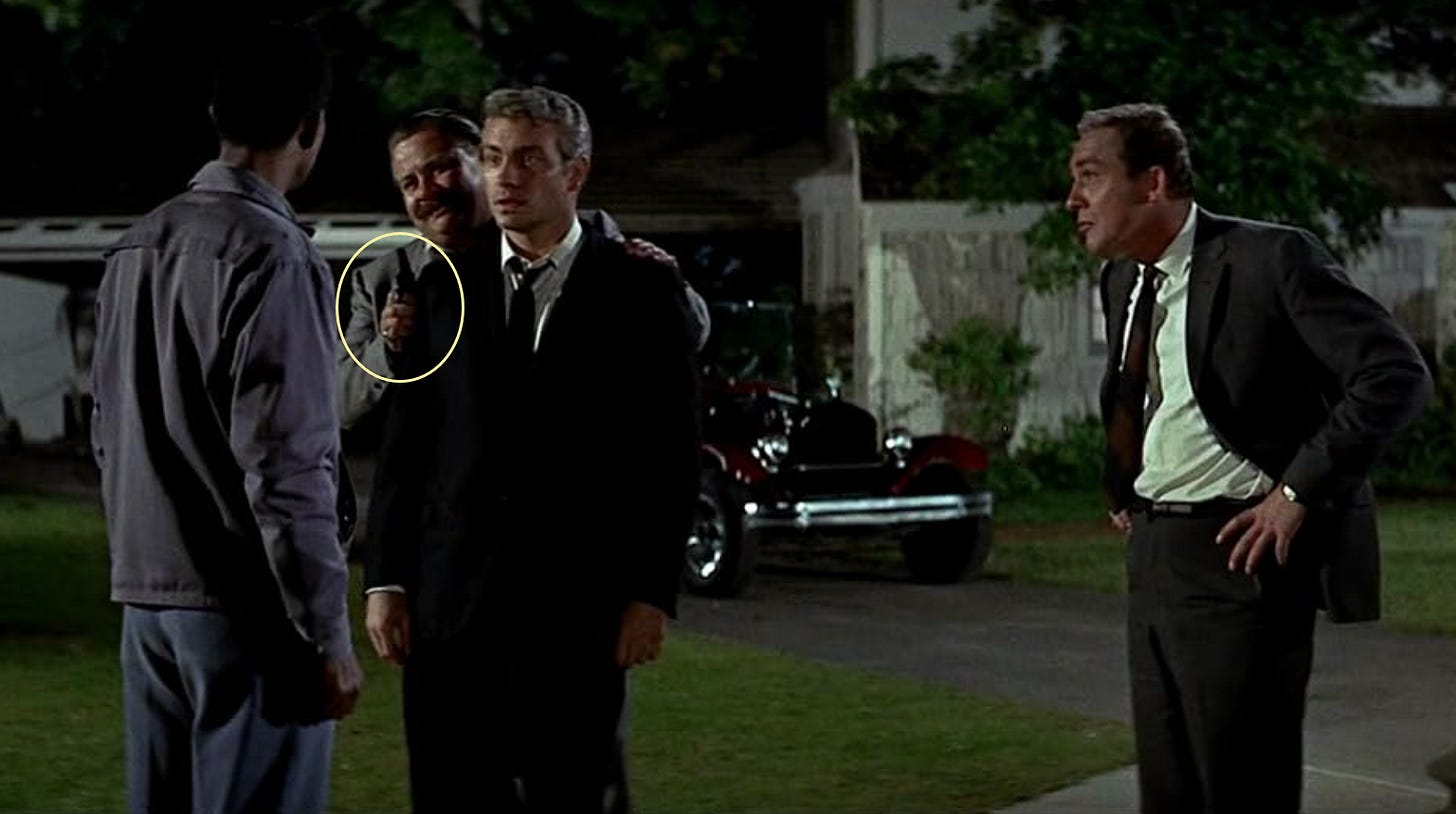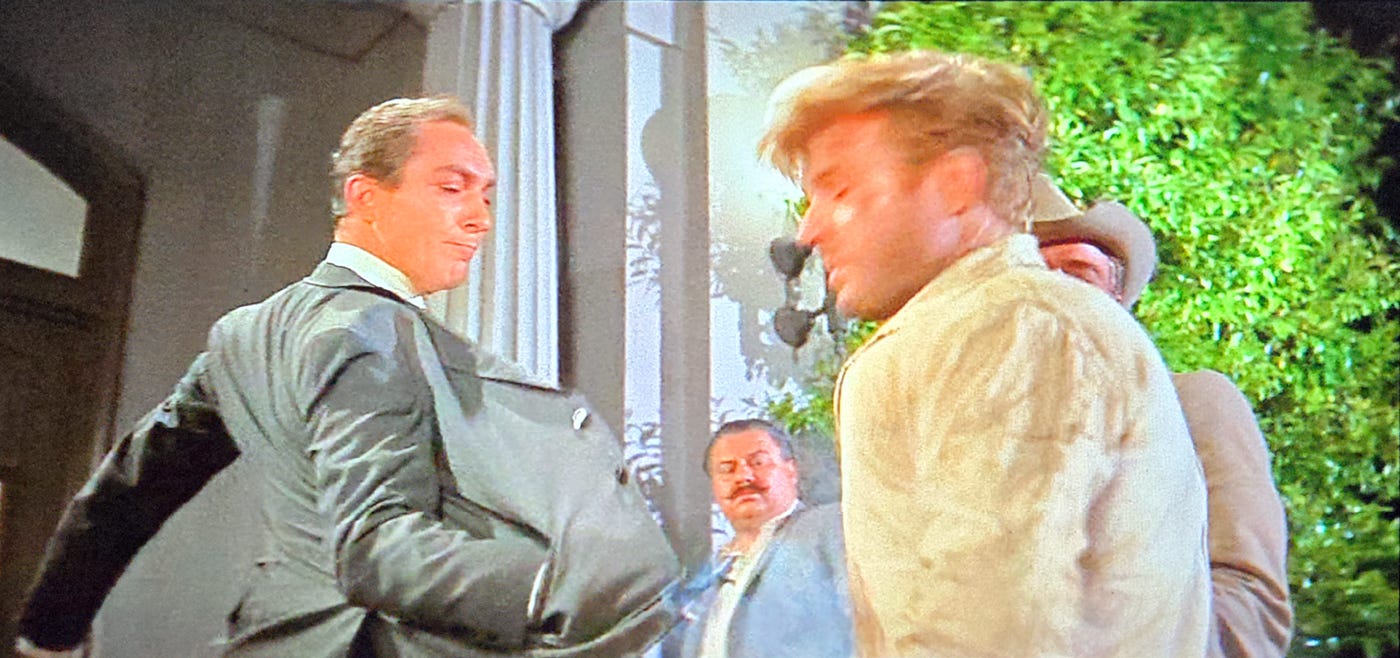Essay: The Chase (1966)
Star-packed small-town potboiler that's part fugitive thriller, part Peyton Place, with some 1960s racial tensions included
The Chase (1966)
Directed by Arthur Penn
Written by Lillian Hellman, from the novel and play by Horton Foote
Listen to this cast: Jane Fonda, Marlon Brando, E.G. Marshall, Robert Redford, Robert Duvall, Angie Dickinson, Janice Rule, James Fox.
As a rule, movies from the mid-60s with that many stars tended to be comedy spectaculars like “It’s a Mad, Mad, Mad, Mad World” or the now-dead genre, the celebrity adventure picture (such as “Around the World in 80 Days” or the not-so-coincidentally biplane-adjacent “Those Magnificent Men in Their Flying Machines”). By 1965, Hollywood producers, freed in the late 50s from the studio system and in the mid-60s from the last vestiges of the Hays Code, could pack the adaptation of any highly-publicized novel or Broadway play with established stars and directors who now had the power to negotiate their own deals. This was an expensive way to make a picture, but it was also a way to distinguish your movie as “star-studded” and therefore high-class — not like the B-movies that were flooding television, which was itself increasingly competing for Americans’ attention (or eyeballs, as we would say today).
Meanwhile novels, and their film adaptations, about the hypocrisy of American small town life had been popular since the 1950s. Along with the psychology/psychiatric disorder-oriented plays by Tennessee Williams, Edward Albee, Eugene O’Neill and the like, in which plots circled around big family secrets like homosexuality or incest that are eventually revealed, the small-town “potboiler” or “hothouse” drama usually depicted a family with a broadly drawn patriarch whose unhappy children were alcoholics, covered-up murderers, “nymphomaniacs,” or merely secretly born out of wedlock.
These novels and films, such as 1956’s “Peyton Place” (which became the shorthand for all such dramas involving small-town scandalous secrets), were popular during the Eisenhower years and afterward because they addressed Americans’ cognitive dissonance. During this era, heterosexuals were compelled economically to conform and to burnish the illusion of the perfection of the churchgoing nuclear family, but the urge to conform to this stereotype was not enough to allow anyone to actually achieve it. The anxiety produced by this pretense was consequently expressed in the era’s novels and plays, set in a confined environment as small as a single institution like a school or prison — Harold Pinter’s 1958 play “The Hothouse,” from which the usage derives, takes place in a sanitarium — or, more often, a small town.
And by the mid-1960s a writer could make the soap-opera-like genre — which was getting a bit stale — seem up-to-date and even “challenging” by adding yet another element: racial tension. Because what’s one more element on top of hard drinking, fornication, closeted “perversion” and small-town graft?
So “The Chase” contains everything viewers could want: A local oilman named Rogers (Marshall) who pulls the strings in the place. His timid employee Edwin Stewart (Duvall) is married to Emily (Rule), a brazen hussy who’s having affairs with Rogers’ other employees. His failson Jake (Fox), who’s really in love with lower-class Anna (Fonda), who’s already married to escaped fugitive Bubber Reeves (Redford). This leaves out a trio of alcoholic local businessmen — their wives are also sluts carrying out affairs almost in plain sight, or just making a spectacle of themselves at parties — who in Act III turn into murderous vigilantes threatening the control of Sheriff Calder (Brando) as well as local Black residents.
Plus a gang of high school kids on the margins who also have parties and get drunk, weirdly (very weirdly) led by a pint-sized fellow in a pink shirt and improbable rock-and-roller haircut, played by none other than Paul Williams, who would become a minor film actor (“Phantom of the Paradise”) but major Hollywood songwriter of the 1970s and 80 (many credits).
I’ve given all the characters and elements of the setting; I really should at least try to summarize the story. It’s this: Brando’s sheriff presides over the town, but so does E.G. Marshall’s patriarch, who appointed him. While much of the town’s moneyed people are living it up, Bubber (Redford) escapes from prison and, against all common sense, makes a beeline to his hometown where his poor mother and father live and where his wife Anna (Fonda) is waiting for him — waiting while having an affair with the failson Jake, that is. As they await news of the community’s prodigal son turned escaped convict, everyone in town gets even drunker than usual to take the edge off. When he finally arrives, he hides in a junkward on the edge of town owned by his African American friend Lester (Joel Fluellen), asking Lester to get a message to his wife, so she can join him as a fugitive, I guess.
With all those stars, and a 2 hr. 14 min. duration, you’d think that something had to give, and that’s the pacing. While playwright Horton Foote (who later novelized his play) no doubt invented all the characters and small-town drama, Lillian Hellman is credited with the screenplay, so I blame her for including too much in Acts I and II. Aside from the escaped convict scenes starring Redford, which are tightly and excitingly shot, much of the first three-quarters are a whole lot of drinking, partying, bad behavior, and slutting around by the townspeople, all of it disapprovingly monitored by Brando playing the town sheriff. And while I found Brando’s performance compelling — and that of Redford, who gives enough comic edge to Bubber to give a foretaste of his role three years later in “Butch Cassidy and the Sundance Kid” — he can’t animate the seemingly endless party sequences or the inevitable soap opera stuff.
At some point in Act II, a trio of local men get so frustrated by having their wives slut it up in front of their noses, and by Brando’s sheriff acting so superior, that they go out looking for trouble. This being Texas, everybody is already armed1, so they start brandishing weapons. When an African American man (Davis Roberts) quietly walks by the party where the white folks are living it up, these men immediately start harassing him. The situation threatens to turn tragic, but is defused when Brando’s sheriff drives up and tells everybody to go home. Significant — at least from our perspective today — is the failure of the sheriff to take away the men’s guns.

This scene, halfway through the movie, is the first depiction of the racial tension present in the nation at the time. The next is in Act III. The same trio of businessmen find Lester looking for Anna so he can tell her where her husband Bubber is hiding. Of course they’re ready to beat the secret out of him; Brando rescues Lester too, and checks him into the jail for his safety. But the vigilantes overpower the sheriff and beat the secret out of Lester anyway. Típped off only slightly ahead of everyone else, the rich guy Rogers (E.G. Marshall) leads the whole town to the auto junkyard on the edge of town where Bubber (Redford), now reunited with Jane Fonda, is hiding out with Rogers Jr. The hopped-up teenagers arrive and start launching flares into the mass of rusting cars, starting fires. Excited by a possible conflagration, they escalate to molotov cocktails, then tires filled with flaming gasoline and rolled down the hill into the mass of flaming junk cars.
You may ask how small town Texas teenagers know how to make molotov cocktails. It’s because this is a lynching.
Despite the junkyard burning down, accidentally killing the failson that Jane Fonda has been carrying on with, somehow Brando’s sheriff succeeds in bringing Redford safely back into town. But Bubber is gunned down on the steps of the jail by one of the vigilantes, who fires a revolver from a stance reminiscent of Jack Ruby when he shot down Lee Harvey Oswald.

The viewer may ask themselves why a director might restage the Oswald assassination in a non-political non-thriller movie made two years after it happened. To the extent that the scene does resemble the historical moment, I think it’s because in 1965 there was still no recent event more on the minds of Americans, aside from the Beatles and the space program, than the events of November 1963. It’s just natural that when a script called for a vigilante to shoot a criminal suspect on the steps of a jail, the scene would come out looking like Oswald’s killing whether or not the director meant it to.
While the film’s killing of Bubber — who may be an escaped fugitive but a white one — doesn’t directly evoke American racism, the scene is reminiscent of another scene that does: the white mob gathering in front of a jail intent on lynching a black man as depicted in “To Kill a Mockingbird” (1962, based on the 1960 Harper Lee novel) — a film script written by the author of “The Chase,” Horton Foote. (And Robert Duvall, who played Boo Radley in “Mockingbird,” appears in both films.)
“The Chase” is a rewarding movie to watch, with patience. Brando’s and Redford’s performances are among their best, and Jane Fonda also acquits herself well. If you can sit through — or even fast-forward through — the soap opera scenes, the chaos of Act III is admirably handled by Penn, who would become one of Hollywood’s top directors. In the next ten years he would helm “Bonnie and Clyde,” “Little Big Man,” and “The Missouri Breaks” (the latter also with Brando). It’s certainly not a documentary (“The Sugarland Express” would capture the small-town Texas mentality more realistically several years later). But it does capture what Hollywood and the rest of the country thought the South was like, as the nation tried to understand why so many of its residents were still fighting a rear-guard action in the Civil War from a hundred years before.
“The Chase” is streaming on the Criterion Channel.
While many events in the movie are a hyperbolic depiction of life in the American South, the suggestion that everyone in Texas at the time was packing heat is realistic.






